Some of my menswear photos from Pitti Uomo 2022 in Firenze. More on my Instagram Account.
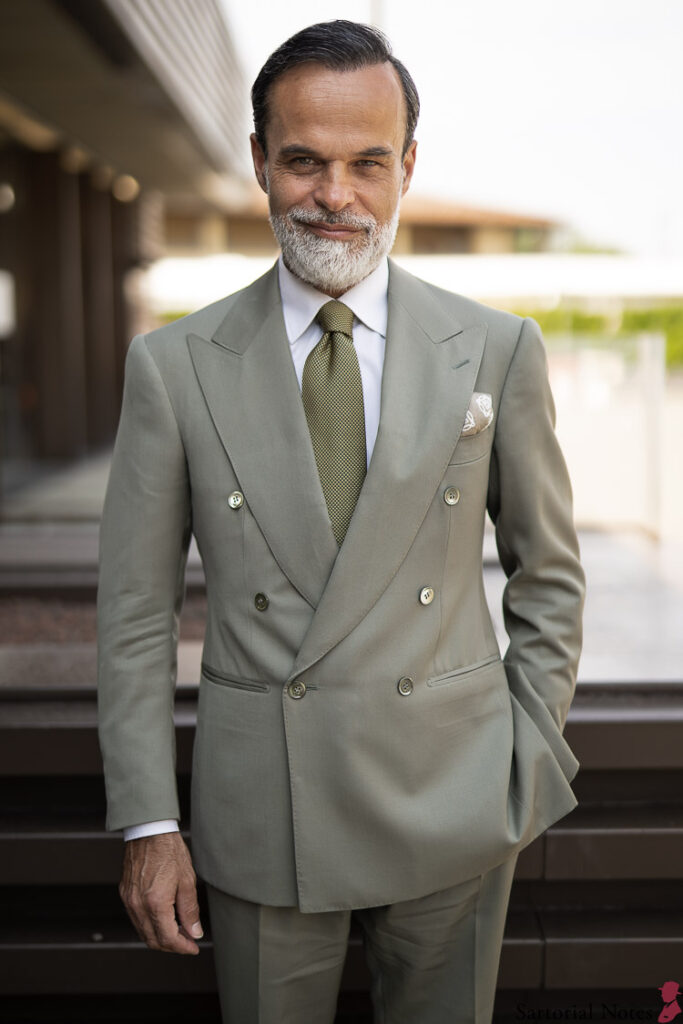
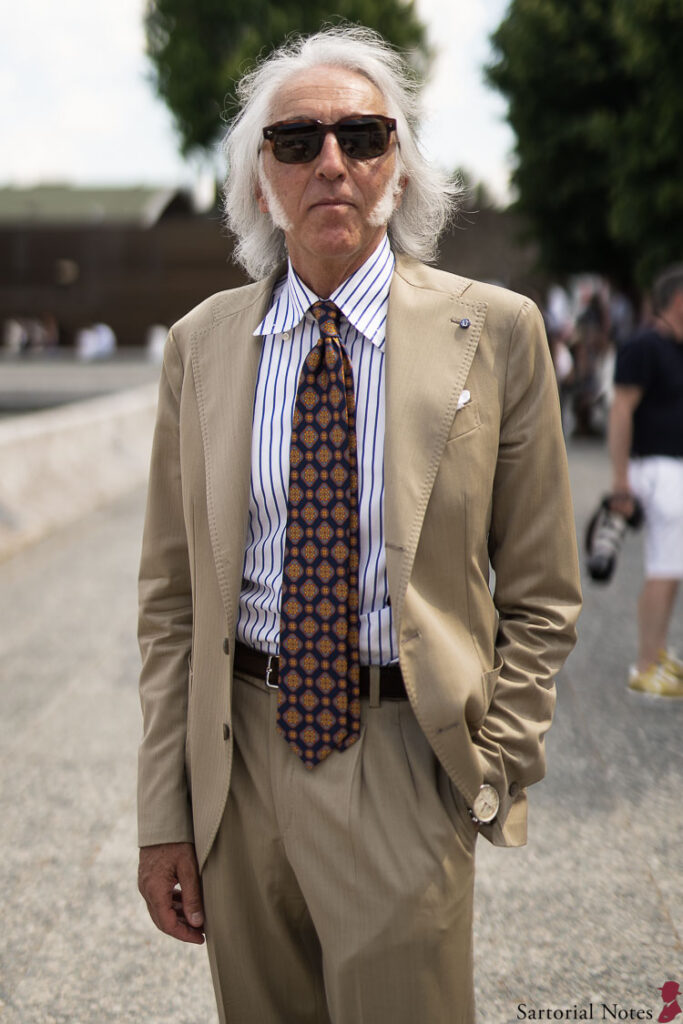

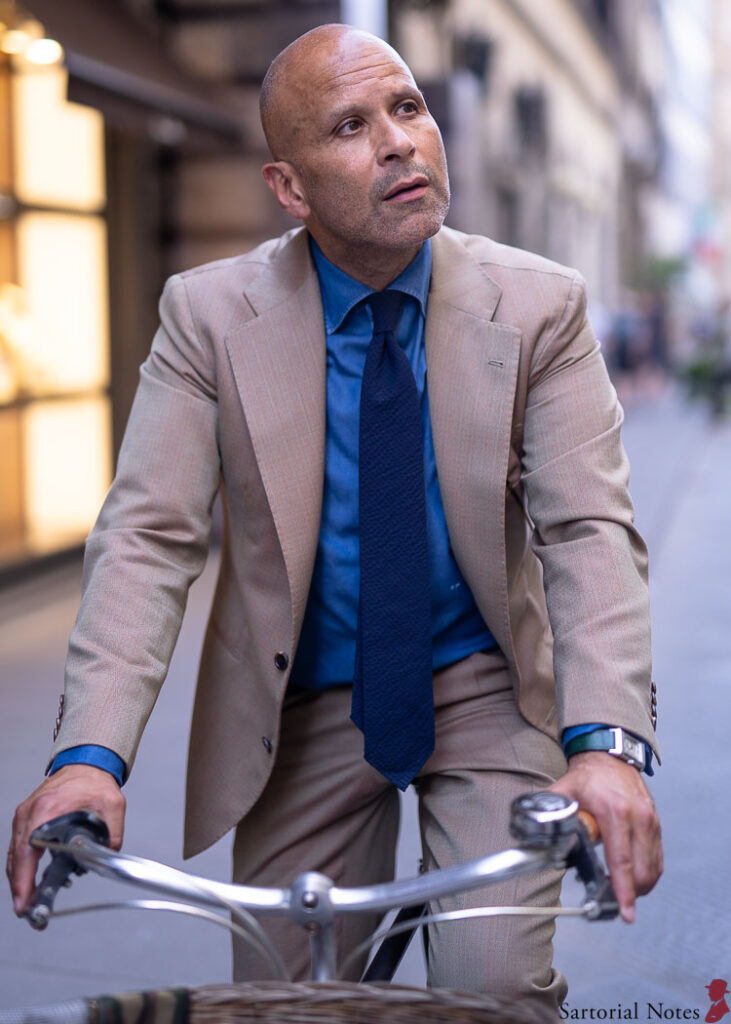


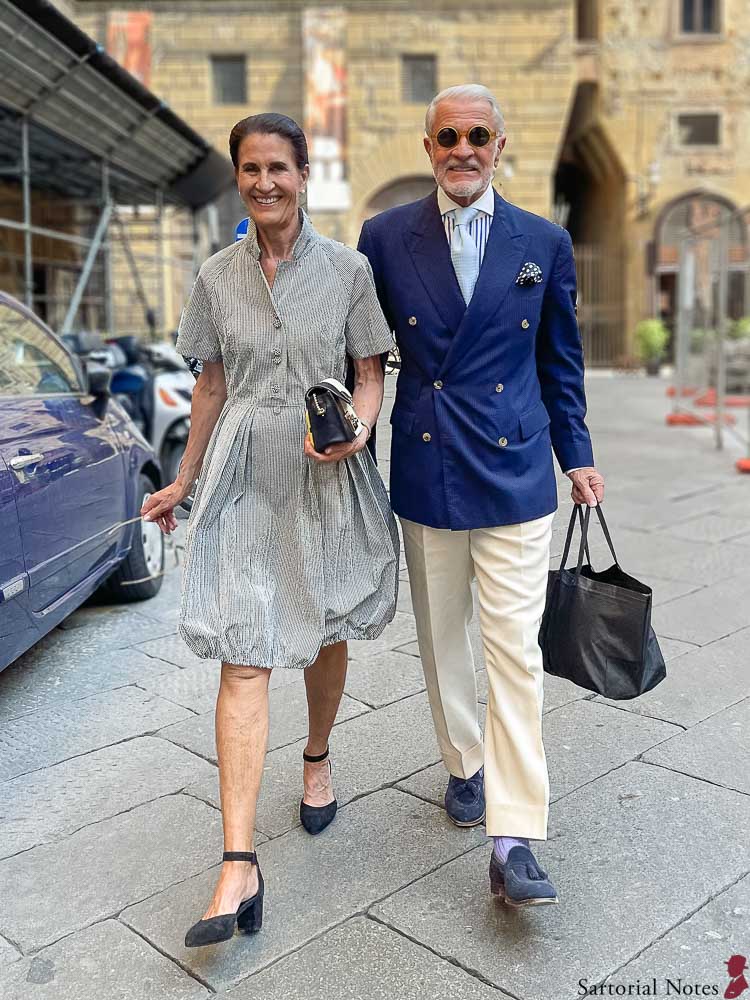
by Torsten
Some of my menswear photos from Pitti Uomo 2022 in Firenze. More on my Instagram Account.







by Torsten
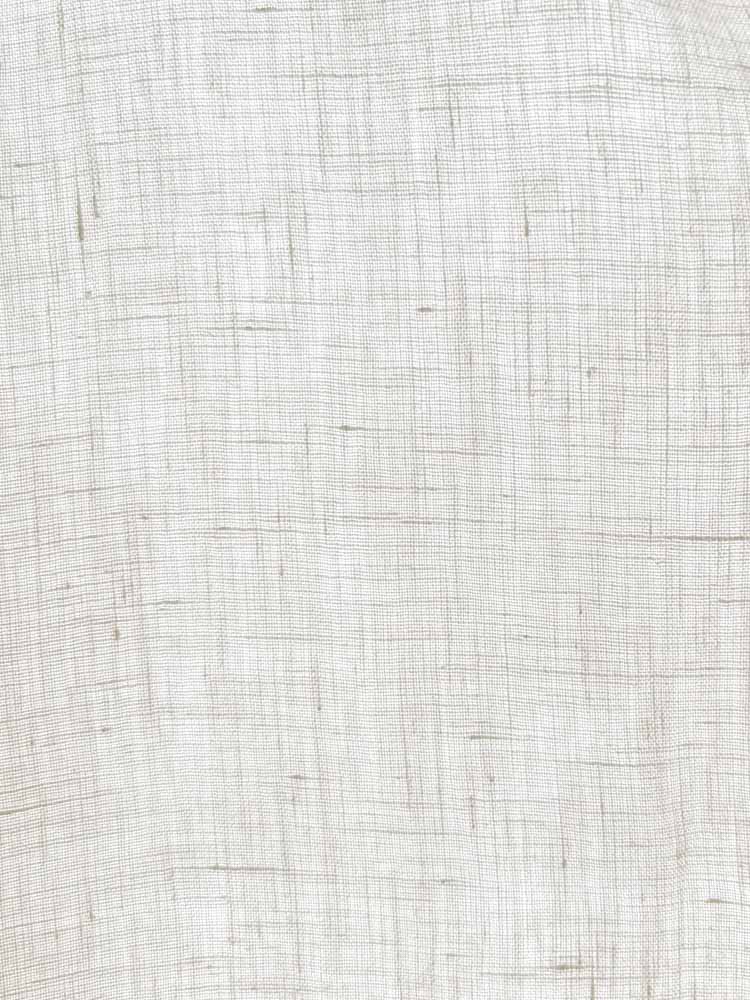
Linen shirts are the new cotton shirts
It’s not like that. Cotton shirts won’t be phased out any time soon. However, it is reasonable to say that linen shirts and other linen garments look to become a long-lasting trend because they support the movement towards sustainable fashion.
But linen creases, doesn’t it?
Linen creases, yes. The fibres are stiff and “break” as soon as you button your freshly ironed linen shirt. On the other hand, the creases are exaggerated. Much (the better!) linen keep up quite well from morning to night, and then there’s the fact that the breaks actually start to soften as soon as they’ve occurred. The hard edges round off as the day passes by.
And, then you have the benefits:
Breathes well
Studies show that linen is one and a half times better at dissipating body heat than cotton shirtings. In practice, this means that the temperature behind a linen shirt can be lowered by 3-4 degrees on warmer days.
Dries quickly
If you sweat in your shirt, a linen shirt will dry faster than an otherwise equivalent cotton shirt.
Comfortable
Comfort is partly a matter of personal taste. However, most people prefer their fabric not to scratch. Linen also excels here. Run a hand over linen and you’ll experience a softness you won’t find if you perform the same tactile check on a cotton fabric. Linen is also totally anti-static, no pain, but pure pleasure when dressed in linen.
Durable
If an ordinary men’s shirt lasts three years, a linen shirt lasts four. Although linen shirts will often cost a little more than cotton shirts, you will also wear them longer.
Sustainable
As well as potentially lasting longer, only 1/4 of the water used to make a cotton shirt is used to make a linen shirt.
by The Boss
Men’s fashion has died. It changes the perspective on how to dress. A comment in connection with my new book about dressing well. It’s in Danish only, however if you would like it just for the many illustrations, feel free to order it. I can ship it abroad. Choose “Levering til døren (49 DKK)”: https://denvelklaedtemand.dk/2020/12/stil-bestaar-bestil-bogen-nu.html
by The Boss
In his autobiography In My Own Fashion (1987) designer Oleg Cassini writes about “the last playboy”, Porfirio Rubirosa (1909-1965). I haven’t come across a better portrait. It also tells a thing or two about Oleg Cassini himself.
Oleg Cassini on Porfirio Rubirosa:
“When I think of the man who truly embodied the spirit of those times, Porfirio Rubirosa is the one who comes to mind. He was an apotheosis, the ultimate playboy, a strange combination – one of the few Don Juans I’ve ever met who was a man’s man and a ladies’ man. Rubi was an athlete – he played polo and boxed – but he also had the gift of knowing how to talk to women. He was of medium height, well muscled but trim, with rugged good looks … and, of course, he had the most remarkable piece of equipment; he was known for it. A common joke when dining out in those days was to refer to the sixteen-inch pepper mill as “the Rubirosa.” His nickname was Towjours Prêt (“always ready”). It would be a mistake, though, to attribute his great success with women solely to the beneficence of nature. Rubi was one of the most charming men I’ve ever met, a man who knew quality and devoted himself to enjoying the best things in life.
I know there are those who scorn the unbridled pursuit of pleasure. But I will not indulge in the middle-class morality of shopkeepers when judging Rubi. I will say only this: everyone pursues pleasure in his own way. Whether it is through intellectual stimulation, mystical rapture (I would include religion in this category), or the more tangible excitements of the senses.
I knew Rubi for many years, in Palm Beach and Deauville and New York, but I will always associate him with Paris in my mind. I often visited with him and his last, stunning wife, Odile Rodin, at their petite maison, just outside the city, called Marnes la Coquette. It was surrounded by trees, and brilliantly furnished.
Rubi lived like a pasha and had the most incredible schedule. He had transformed one of the rooms of this house into a boxing ring, and first thing in the morning, he would go there and spar several rounds with a professional boxer. After a shower and breakfast, he might play some polo; he was a low-ranked player but well mounted – or go shopping with Odile. In the afternoon, his coterie would begin to gather; invariably, a there were younger men who surrounded Rubi, seeking to learn his secrets or just enjoy his lifestyle. They would arrange the evening’s entertainment for his amusement. Eventually, Rubi would ask, “So, what do a we do tonight? Let’s do something interesting.”
Often we would go to the Tour d’Argent for dinner. The proprietor of that sumptuous place, Claude Terrail, was a fellow polo player who enjoyed the elegant life as much as we did. “Perhaps,” Rubi would say; “Claude will bring out some of his good ducks for us, for a change.” ‘E ney Tour d’Argent was, of course, known for its duck. After that we would gaa to L’Eléfant Blanc, which was my favorite nightclub of all time—an exciteing place, with two orchestras. Latin rhythms were very popular than was Jazz. In later years, we would go to Regine’s or Castel’s. We. note stay out most of the night. There were always beautiful girls, ce tainkg and competition in that area. There was always the goal of appearingivalll the most beautiful, or most wealthy, or most famous, or most fun.” Toward dawn we would go to Calvados, a café on the Avenue Montaigne, where they served excellent sausage and potatoes. We would eat, and haven other drink, and talk. Rubi could appear to be entirely saturated with alcohol and still perform socially and, more important to him, sexually. More than one night I said to myself, He’s gone. He’s had enough.
And Rubi would be saying, “No, let’s have one more champagne. The night is young, eh, Oleg? Are you kidding? Que personne ne bouge.” (“I don’t want anyone to move.”)
He wouldn’t return home until dawn, and then he would sleep the entire next day. That was how he lived: one day off and one day on. It was one of his secrets, a regimen strictly maintained. You could not call Rubi on the day of rest. Everything was dark. No sound; nothing. He relaxed himself totally, preparing for the next performance, and it seemed to work. I never saw the man look tired or haggard.
There was another, rather exceptional secret about Rubi that directly ivolved his reputation as a lover, and as a man. He suffered from a rare sexual malaise: priapism. He was in almost constant state of arousal but unable to be satisfied. He achieved orgasm very rarely, and then only after hours of struggle. It must have been very painful, and frustrating, although it may well have been a product of Rubi’s obsession. He knew that thing of his was a potential meal ticket, and he actually trained to keep it in peak condition. He did exercises. He would drink each day a potion called pago-palo, which he said came from the bark of a certain tree in the Dominican Republic; he believed that it guaranteed performance. He claimed to be able to think himself from semitumescence to full sail, and I believe he could. He was very proud of his abilities and endowments and would, at times, perform parlor tricks. He could balance a chair with a telephone book on it atop his erection. “It’s a muscle like any other,” he would say. “It can be strengthened.”
I was friendly with Rubi during the last decade or so of his remarkable career. He had already been married to both Doris Duke and Barbara Hutton, the latter for a mere 53 days, during which time she showered an estimated $1 million in gifts and $2.5 million in cash upon him, which must be some sort of record.
Rubi was born in the Dominican Republic, but he did not, as myth has it, come from a lower-class family. His father was a general in the army who later became the Dominican chargé d’affaires in Paris. Rubi went to the best schools, and moved in the best circles of French society. He returned to the Dominican Republic to study law in 1926, at the age of seventeen, but soon left the university for a military career. He was already a captain, at the age of twenty, when he was noticed by the dictator Rafael Leénidas Trujillo, who had recently staged his coup. Trujillo rather pointedly sent Rubirosa to the airport one day to retrieve his plain daughter, Flor d’Oro. Rubi took the hint and married the girl. Trujillo rewarded him with the same diplomatic post his father had held in Paris; remarkably, Rubi remained in the dictator’s good graces even after he divorced the daughter in 1940. He kept his diplomatic post, but, given his fabulous lifestyle, was in constant need of money; and so, he used women to finance him.
He believed his services were fair exchange for the fabulous sums (at least until it became clear that they would not have exclusive rights ultimate serene). In her diary, Barbara Hutton would note: “He is the ultimate socorer, capable of transforming the most ordinary evening into a night of magic.” And also: “{He is] priapic, indefatigable, grotesquely proportioned.”
During the 1940s, Rubi was married to the French film star Danielle Darrieux, and then, in 1947, to Doris Duke, the tobacco heiress. The latter ceremony was marked by a rather bizarre scene. Just before the marriage was about to transpire, a battery of Duke’s attorneys arrived with a prenuptial agreement for Rubi to sign. He was so infuriated by this that he smoked a cigarette throughout the ceremony. His wounded pride was a mitigated somewhat by his wedding presents, which included a check for a $500,000, several sports cars, a converted B-25 airplane (Rubi was a pilot), and the inevitable string of polo ponies. The marriage lasted thirteen months.
The marriage to Barbara Hutton was a complete fiasco. Rubi wage having a much-publicized romance then with Zsa Zsa Gabor (while she was married to George Sanders, who named Rubirosa as corespondent:ifa his divorce petition); Barbara was well on her way to oblivion – she deteriorated physically and mentally – and was furiously squandering her fortune. I could not imagine marrying her in that state, but Rubi was desperate.
You see, he was a true playboy. He was unable to work; the very thought of it made him ill. Indeed, he was quoted by Newsweek as saying “Work? I have no time for work.” (At one point, Rubi sent a young dominican named Oscar Renta to me, to work as a design assistant. I didn’t have anything for him, but Mother made some introductions; later he became the famous designer Oscar de la Renta.) I remember once, years later, Rubi had lunch with me at a Chinese restaurant in New York. I knew he needed money and I had a plan. He and I would open ski resort in Europe. It would be very exclusive, membership only (like: the Ski Club Ten at Sugarbush, Vermont, which I opened). I had a specific mountain in mind, not forty-five minutes from Nice and virgin territory. “This could be very big,” I told him. “Everybody knows you, and likes you. People would be dying to become members.”
He listened, dully, as I went on for about twenty minutes. Finally, he pleaded with me: “Stop, Oleg, stop. I have a headache. ‘This business talk is killing me.” I was amazed. He considered my relatively vague fantasizing business. He couldn’t continue. He had to go to bed. Rubi’s mind was attached to la dolce vita and a few sports: the very idea of earning a living exhausted him, And yet, it was something that he had to think about often in the last years of his life, since he had done something that was, for him, rather odd: he had married for love.
Odile was a teenager when he met her, an aspiring actress who came from a middle-class family. She was about five foot seven, with blondish hair, blue eyes, freekles – she had joie de vivre and was altogether lovely. He was madly in love with her, though. There was a chemistry, a remarkable thing. Odile had the key that unlocked him. She had cured his priap‘sm … and she drove him crazy. Odile had the power over him that he had, all his life, wielded over others. She exhausted him, and made him jealous. She liked to have fun. She even liked the scene, the crowd that followed Rubi about. She could stay out all night just as he could. “I don’t understand it,” he said to me. “All my life I have controlled women – every woman I’ve ever met, except this one. She is under my skin.”
I was with Rubi the night he died. He was worried about money. He was worried about Odile, with whom he’d quarreled. She’d gone out with someone else. There was a celebration that night: a victory by the Brazilian polo team. Normally, he would have gained a great deal of satisfaction from such an occasion. Champagne was being poured into the championship cup; everyone was laughing, drinking. I remember looking at his face. He was trying to smile, but the fun had gone out of him. His eyes were dead. He said to me, “Eh bien, Oleg, let’s go out. We’ve had enough of this. Let’s go to Calvados and have a drink or two.”
Rubi unburdened himself as we drank: “Oh, I am not happy. It is always the same thing. I don’t have any money. I don’t know if I should sell my house. I don’t know what’s going to happen … Odile, she is impossible.” It was getting late and I had business the next morning. I was staying at the Hôtel George V, just down the block from the café, and wanted to excuse myself. Rubi was not yet ready to call it an evening, of course. He said, “Hey, mon vieux, come and stay with me at the house. We can have another glass of champagne and talk.”
“At another time – any other time, my friend – I will come for breakfast, or lunch. We can talk all night some other night, but I have an appointment early in the morning. I must go,” I told him. “Go home, go to bed.”
I remember thinking I should go with him.
But then, I’d seen him in that condition so many times. Rubi could hold his liquor better than anyone I knew. He never would have allowed me to drive his Ferrari racer, in any case. And I did have business the next morning. I thought about it and then shrugged it off.
The next morning I learned that Rubi had driven his car full speed into a tree, not more than a mile from the café, and killed himself. I am not certain if the true cause of death was alcohol or depression, but perhaps it was for the best. It was 1965, and Rubi’s time was passing. He would not have been happy with the sexual revolution.”
by The Boss
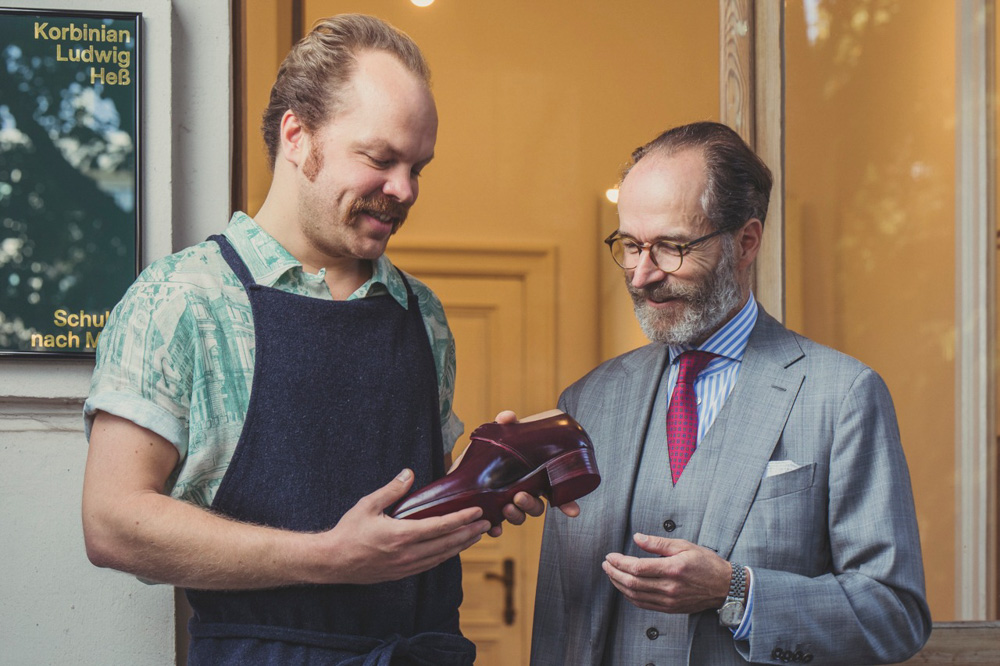
Menswear writer Bernhard Roetzel, author of the best selling book world-wide on classic menswear, “Gentleman”, has a new book out on bespoke shoes: “Herrenschue nach Mass”.
This first edition of the book is in German only, yet Bernhard Roetzel expects the book will be translated to English shortly.
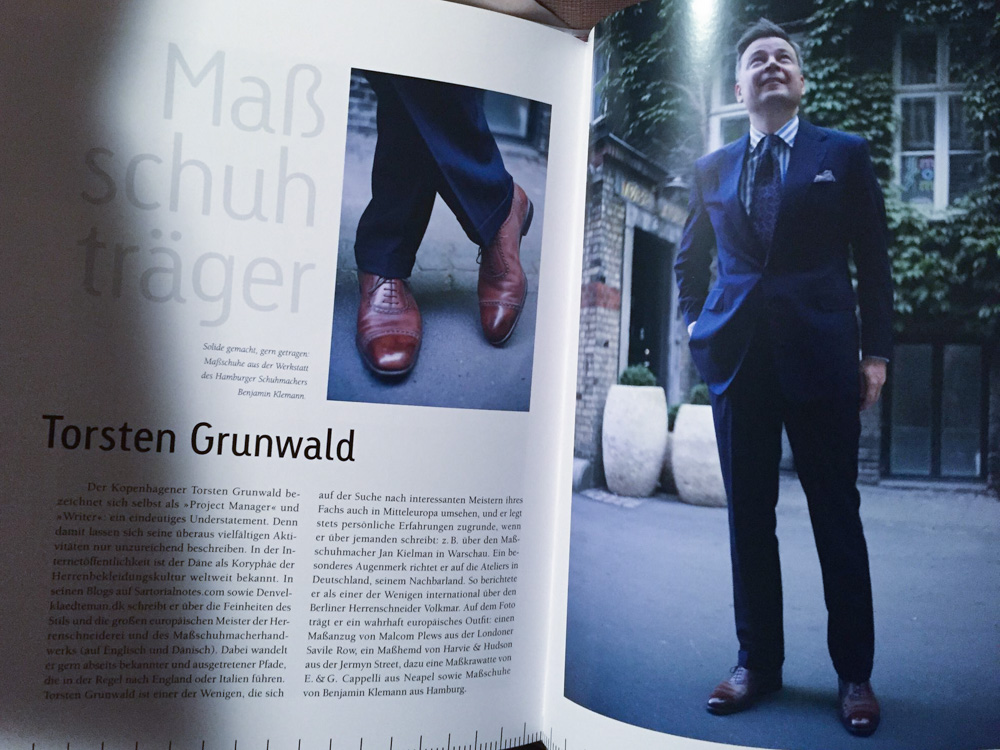
I’ve talked with Mr Roetzel about his latest book on bespoke shoes. I should say he features me in a couple of pages of the book calling me “a pioneer in the sartorial community”, which is of course very kind of him.
1) Bernhard, what knowledge would you like to bring to readers with your new book?
Many people know the term “bespoke shoes” but they don’t really know what bespoke shoes are, how they are made, what advantages they have and which difficulties a customer may face when ordering them. My book tries to answer all these questions in necessary detail but in a comprehensive way. Some authors offer too many details that are not relevant which leads to confusion. Other customers are used to wearing ready-to-wear Goodyear welted shoes which they think fit well although this is very often not the case. I try to explain how shoes should fit. Another question that I write about are the pros and cons of try-on shoes. I explain the different points of views to allow the reader to make a decision for himself.
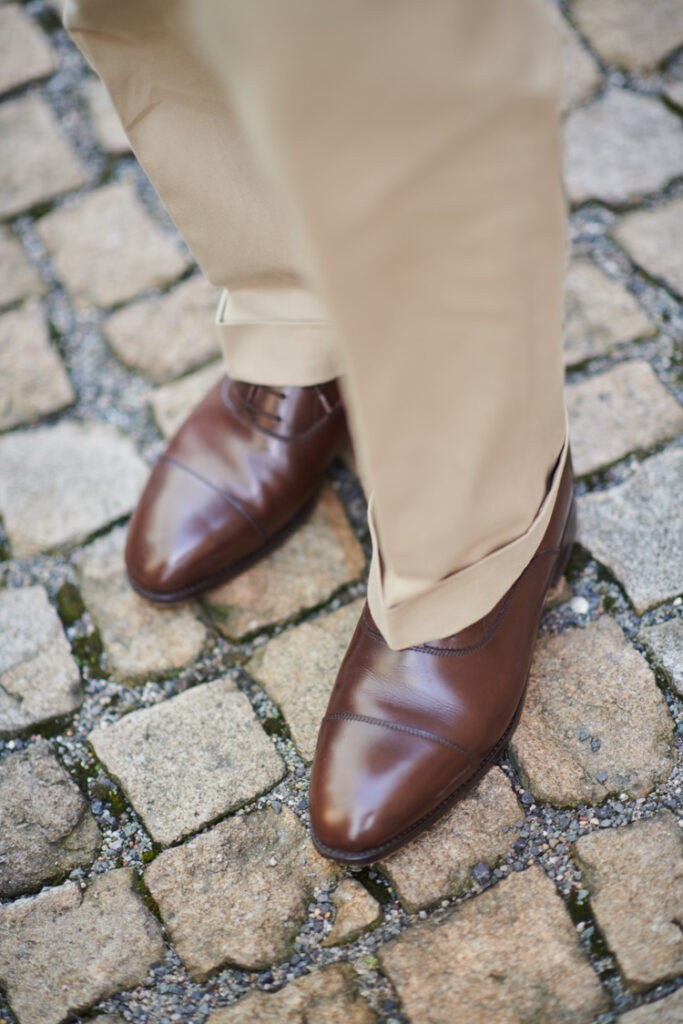
2) How does the book differ from the old Vass book on bespoke shoes?
At first glance it looks similar which was our intention because my book is meant to replace the old book. Nevertheless I have written a completely different book although the sequence of the chapters is also based on the steps of the shoemaking process.
The first difference is that my book has been planned and written by one person including the direction of the photography. I was present at most of the photoshootings in Berlin which was very helpful for me because I learned a lot while I watched Korbinian Ludwig Heß and his uppers maker from Japan Shigeki Motozuka. The old book was born because the original publisher had met Mr Vass. As Mr Vass is not a writer they needed to find someone to actually write the book. When you read this book you don’t really know who you are listening to. I was involved in the old book at a late stage as a consultant, you can find my name with a credit in the book. I always liked the old book and I know that it has a certain cult state similar to my book “Gentleman” although I found twenty years ago that it focussed a bit too much on Hungarian shoes. I also wanted a different style of photos. I think Martin Smolka and Tommi Aittalla did a phantastic job. We have hundreds of pictures left that we couldn’t use for lack of space.
Another difference is my rather unemotional, matter-of-fact attitude towards the subject. I am not a bespoke shoemaker trying to convince readers that bespoke shoes are the best option for everyone. I do see the weak points and I try to blow away the mist surrounding the subject.
3) What’s your position in the sartorial debate about the advantages of bespoke shoes vis-a-vis ready-to-wear shoes?
If your feet have no peculiarities, if they are totally evenly shaped and match the sizes perfectly, then you can use ready-to-wear lasts all your life and be very happy. Buying ready-to-wear has many advantages, the biggest is that you see and can try what you get. There are so many beautifully made shoes on the market in different price categories that you can find something for almost every taste. But even with totally even feet you could still decide to order bespoke shoes just for the fun of it, for the fun of having something made especially for yourself. This is one big reason why people order bespoke shoes although they are very happy with what they get off-the-rack. Then we have many men with irregular feet, with odd toe shapes, with different feet lengths, with very narrow heels and a wide forefoot and so on. They will never find welted shoes that will fit them correctly and that feel good on their feet. Some could find better shoes using made-to-order or made-to-measure but a good bespoke shoemaker will make a big difference for everyone who’s feet are far beyond the norm. I don’t think that a completely handmade shoe is very much better technically. A Goodyear welted shoe made of good raw materials will last very, very long if you look after it. I don’t believe that the handwork results in a shoe that will last longer. I have both bespoke shoes and ready-to-wear shoes that are 20 or more years old.
Once you do find the bespoke shoemaker who makes a shoe for you that is perfect or as good as physically possible you will notice the difference. Before you find these shoes you will not notice a significant difference to your best pair of ready-to-wear shoes. In fact I have had bespoke shoes made that fitted much worse than ready-to-wear.
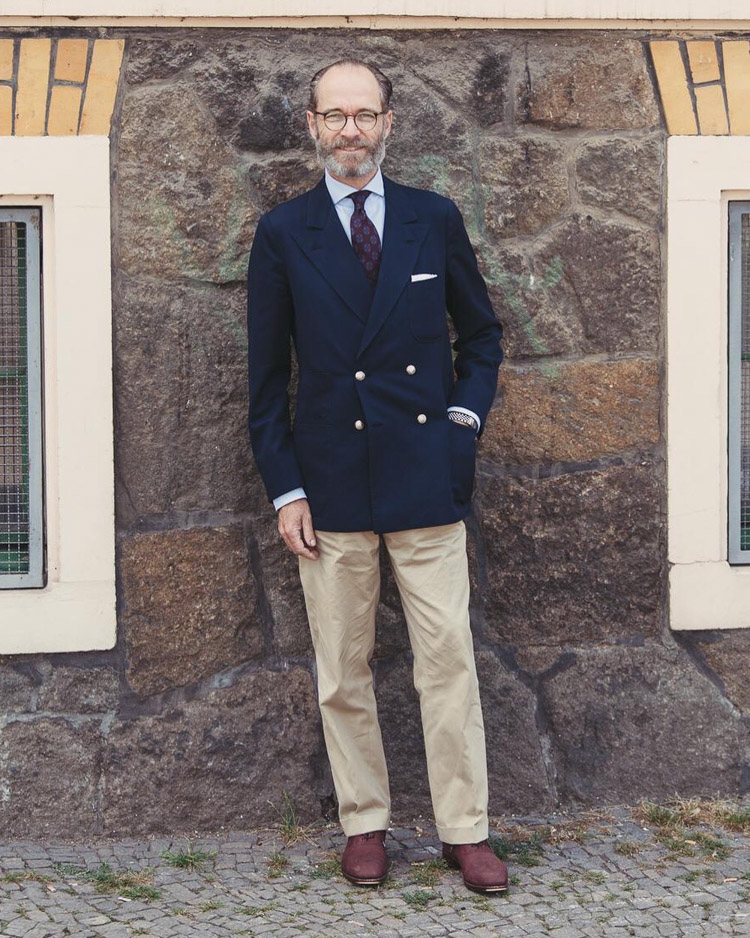
4) How would you rank design, fit and make, when it comes to shoes?
When I buy ready-wear I go by the look of a shoe first of all. Then I try it on and if doesn’t fit I don’t buy it. If I have two different pairs of a similar style, say a black captoe Oxford, and if both fit equally well I will buy the pair that looks better and offers better value. If I don’t like the way a shoe looks I will never buy even if it fits very well. Clarks Wallabees are extremely comfortable for example but they don’t match my clothing style so I don’t wear them although have bought them in the past. I love the way some shoes from Tricker’s look but I have never bought a pair because they are too wide for my feet. The make has become of less importance to me over the years. 20 years ago I preached that welted shoes are best but now I know that other makes can be very good if the last is good.
When it comes to judging bespoke shoes it is a bit different because one usually doesn’t know in advance what the shoes will look like if you order for the first time. When I look for a bespoke shoemaker I judge him by the samples although they only show part of the truth because they are usually made for very regular foot shapes. For me the personality of the shoemaker is important, if I like and I trust him I am pretty confident. But if the shoes don’t fit it doesn’t help. Bespoke shoes must appeal to my eyes and they must be well made in comparison to other shoes that I own and in comparison to their price but first of all they must fit. Ill fitting bespoke shoes usually hurt more than ill fitting ready-to-wear shoes. On the other I will tolerate lacks in the look and the quality of the making if the shoes fit very well. I even like it when bespoke shoes look a bit strange, I don’t expect them to be as beautiful as a pair of shoes form Gaziano & Girling, Aubercy or Zonkey Boot. As long as they fit well.
5) How do you see the state of bespoke shoemaking in Germany and elsewhere?
It’s really difficult to make a judgement because one can only try very few bespoke shoemakers personally. I used to say that a try-on shoe is absolutely essential, since I had very well fitting shoes made without a trial pair by Kay Gundlack I have changed my mind. His shoes fit better than any other pair of bespoke shoes made after a fitting. Generally speaking I would say that German and Austrian bespoke shoemakers very often have a background in orthopaedic shoemaking which results in a very good fit if they get the shoes right. Sometimes German shoes don’t look as attractive as Italian shoes but in this case the fit is more important. Personally I would use German, Austrian, Czech or Romanian shoemakers rather than English, French, Spanish or Italian, because I like to see a craftsman in his workshop rather than at trunkshows. I would also like to try a female shoemaker one day, I really like the work of Vivian Saskia Wittmer in Florence for example.
Generally speaking I am confident about the future of bespoke shoemaking, there are a number of promising young shoemakers active in many parts of Europe and I think that we will see a small Renaissance of the craft.
You can buy Bernhard Roetzels new book here (IN GERMAN ONLY).
Get new posts by email
